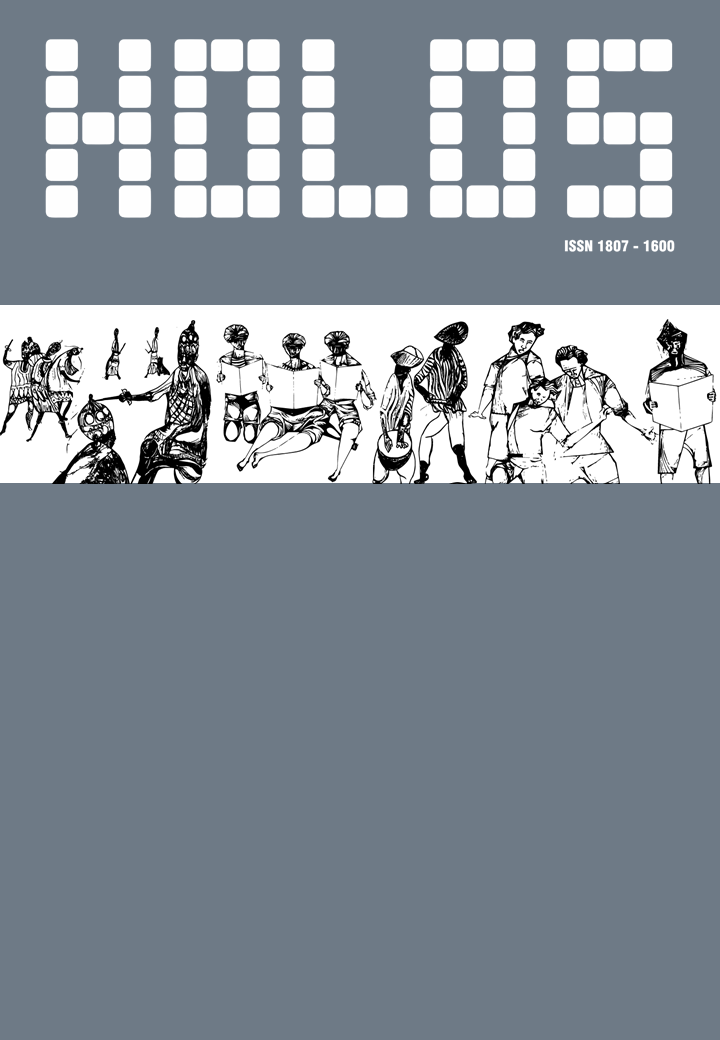CIBERADIÇÃO E ‘CYBERBULLYING’ EM CONTEXTOS EDUCATIVOS
DOI:
https://doi.org/10.15628/holos.2024.17350Palavras-chave:
cyberbullying, ciberadição, prevenção, educação.Resumo
Não se conhecem em detalhe quais são os efeitos das Tecnologias da Informação e Comunicação (TICs) nas pessoas e no processo educativo. As TICs oferecem possibilidades até há pouco desconhecidas, mas seu uso inadequado ou abusivo também as torna instrumentos prejudiciais. Em âmbitos escolares, por exemplo, o mau uso da tecnologia pode aumentar o eficientismo, o pragmatismo e a perda de sentido da realidade educativa. Não podemos esquecer os graves riscos derivados de um uso problemático da tecnologia, como o isolamento, o tecnoabuso, a ciberadição, o cyberbullying, o consumo pornográfico, etc.
Nas páginas seguintes, nos concentramos na compreensão pedagógica de certos problemas relacionados com a tecnologia e a educação, especificamente no cyberbullying e na ciberadição, com o objetivo de avançar na utilização saudável dessas ferramentas.
Downloads
Referências
Alonso Fernández, F (2003). Las nuevas adicciones. Madrid, TEA Ediciones.
Avilés, J. M. (2013). Análisis psicosocial del ciberbullying: Claves para una educación moral. Papeles del Psicólogo, 34 (1), 65-73.
Berchtold, A., Akre, C., Barrense-Dias, Y., Zimmermann, G. y Surís, J.-C. (2018). Daily internet time: towards an evidence-based recommendation? European Journal of Public Health, 28 (4), 647-651.
Bhushan, S., Sachdev, A., Sachdeva, V., Anand, S., Kumar, S. y Kumar, V. (2020). Internet addiction - a mental ‘disorder’. International Journal of Advanced Science and Technology, 29 (7s), 935-936.
Bickham, D. S. (2021). Current Research and Viewpoints on Internet Addiction in Adolescents. Current Pediatric Research, 9 (1), 1-10. doi: 10.1007/s40124-020-00236-3.
Cheng, C. y Li, A. Y. (2014). Internet addiction prevalence and quality of (real) life: a meta-analysis of 31 nations across seven world regions. Cyberpsychology, Behavior, and Social Networking, 17 (12), 755-760.
De’, R., Pandey, N. y Pal, A. (2020). Impact of digital surge during Covid-19 pandemic: a viewpoint on research and practice. International Journal of Information Management, 55.
Díaz-Aguado, M. J. (2023). Resumen del estudio sobre acoso escolar y ciberacoso en España en la infancia y en la adolescencia. Universidad Complutense de Madrid-Fundación Cola Cao. https://www.ucm.es/file/informe-estudio-acoso-escolar-universidad-complutense-fundacion-colacao?ver
Ding, K., Shen, Y., Liu, Q. y Li, H. (2024). The Effects of Digital Addiction on Brain Function and Structure of Children and Adolescents: A Scoping Review. Healthcare, 12, 15. https://doi.org/10.3390/healthcare12010015
Dong, H., Yang. F., Lu, X. y Hao. W. (2020). Internet addiction and related psychological factors among children and adolescents in china during the coronavirus disease 2019 (COVID-19) epidemic. Frontiers in Psychiatry, 11.
Echeburúa, E. (2000). ¿Adicciones sin drogas? Las nuevas adicciones: juego, sexo, comida, compras, trabajo, internet. Bilbao, Desclée de Brouwer.
Favini, A., Gerbino, M., Pastorelli, C., Zuffianò, A., Lunetti, C., Remondi, C., Cirimele, F. Gómez Plata, M. y Giannini, A. M. (2023). Bullying and cyberbullying: Do personality profiles matter in adolescence. Telematics and Informatics Reports, 12, 100108.
Grunin, L.; Yu, G. y Cohen, S. S. (2020). The relationship between youth cyberbullying behaviors and their perceptions of parental emotional support. International Journal of Bullying Prevention, 1-13.
Hughes, T. (2018). Tom Brown's Schooldays. The Project Gutenberg Ebook. https://www.gutenberg.org/files/1480/1480-h/1480-h.htm#link2HCH0017
Karacic, S. y Oreskovic, S. (2017). Internet addiction through the phase of adolescence: a questionnaire study. JMIR Mental Health, 4 (2).
Kuss, D. J., van Rooij, A., Shorter, G. W., Griffiths, M.D. y van de Mheen, D. (2013). Internet addiction in adolescents: Prevalence and risk factors. Computers in Human Behavior, 29(5), 1987-1996.
Lakshmana, G., Kasi, S. y Rehmatulla, M. (2017). Internet use among adolescents: Risk-taking behavior, parental supervision, and implications for safety. Indian Journal of Social Psychiatry, 33, 297-304.
Luengo, J. A. (2014). Ciberbullying. Prevenir y actuar. Guía de recursos didácticos para centros educativos. Madrid, Colegio Oficial de Psicólogos de Madrid. http://www.copmadrid.org/webcopm/recursos/CiberbullyingB.pdf
Martínez-Monteagudo, M. C., Delgado, B., García-Fernández, J. M. y Rubio, E. (2019). Cyberbullying, Aggressiveness, and Emotional Intelligence in Adolescence. International Journal of Environmental Research and Public Health, 12; 16 (24), 5079. doi: 10.3390/ijerph16245079. PMID: 31842418; PMCID: PMC6950617.
Martínez-Otero, V. (2017). Acoso y ciberacoso en una muestra de alumnos de Educación Secundaria. Profesorado. Revista de currículum y formación del profesorado, 21 (3), 277-298.
Olweus, D. (1998). Conductas de acoso y amenaza entre escolares. Madrid, Morata.
Portilho Carvalho, T., Carvalho Relva, I., y Monteiro Fernandes, O. (2023). Addiction to the Internet and Cyberbullying in Adolescents and Young Adults. Revista Interamericana de Psicología/Interamerican Journal of Psychology, 57(1), e1669. https://doi.org/10.30849/ripijp.v57i1.1669
Sorrentino, A., Esposito, A., Acunzo, D., Santamato, M. y Aquino, A. (2023). Onset risk factors for youth involvement in cyberbullying and cybervictimization: A longitudinal study. Frontiers in Psychology, 19; 13, 1090047. doi: 10.3389/fpsyg.2022.1090047. PMID: 36743647; PMCID: PMC9893029.
Su, W.; Han, X.; Jin, C.; Yan, Y. y Potenza, M. N. (2019). Are males more likely to be addicted to the internet than females? A meta-analysis involving 34 global jurisdictions. Computers in Human Behavior, 99, 86-100.
Throuvala MA, Griffiths MD, Rennoldson M, Kuss DJ. School-based Prevention for Adolescent Internet Addiction: Prevention is the Key. A Systematic Literature Review. Current Neuropharmacology, 17 (6), 507-525. doi: 10.2174/1570159X16666180813153806.
Tokunaga, R. S. (2010). Following you home from school: A critical review and synthesis of research on cyberbullying victimization. Computers in Human Behavior, 26(3), 277–287. https://doi.org/10.1016/j.chb.2009.11.014
Torrego, J. C. (Dir.) (2023). Estudio estatal sobre la convivencia escolar en centros de Educación Primaria. Equipo IMECA-UAH, Universidad de Alcalá, Ministerio de Educación y Formación Profesional y Observatorio Estatal de la Convivencia Escolar. https://www.educacionyfp.gob.es/dam/jcr:f3070940-540d-4ea9-b85a-8f9fcc301c1b/estudio-estatal-sobre-la-convivencia-escolar-en-centros-de-educacion-primaria-vf.pdf
Vondráčková, P. y Gabrhelík, R. (2016). Prevention of Internet addiction: A systematic review. Journal of Behavioral Addictions, 5(4): 568-579.
WHO (2024). One in six school-aged children experiences cyberbullying, finds new WHO/Europe study. Disponible en: https://www.who.int/europe/news/item/27-03-2024-one-in-six-school-aged-children-experiences-cyberbullying--finds-new-who-europe-study
Downloads
Publicado
Como Citar
Edição
Seção
Licença

Este trabalho está licenciado sob uma licença Creative Commons Attribution-NonCommercial-NoDerivatives 4.0 International License.









































